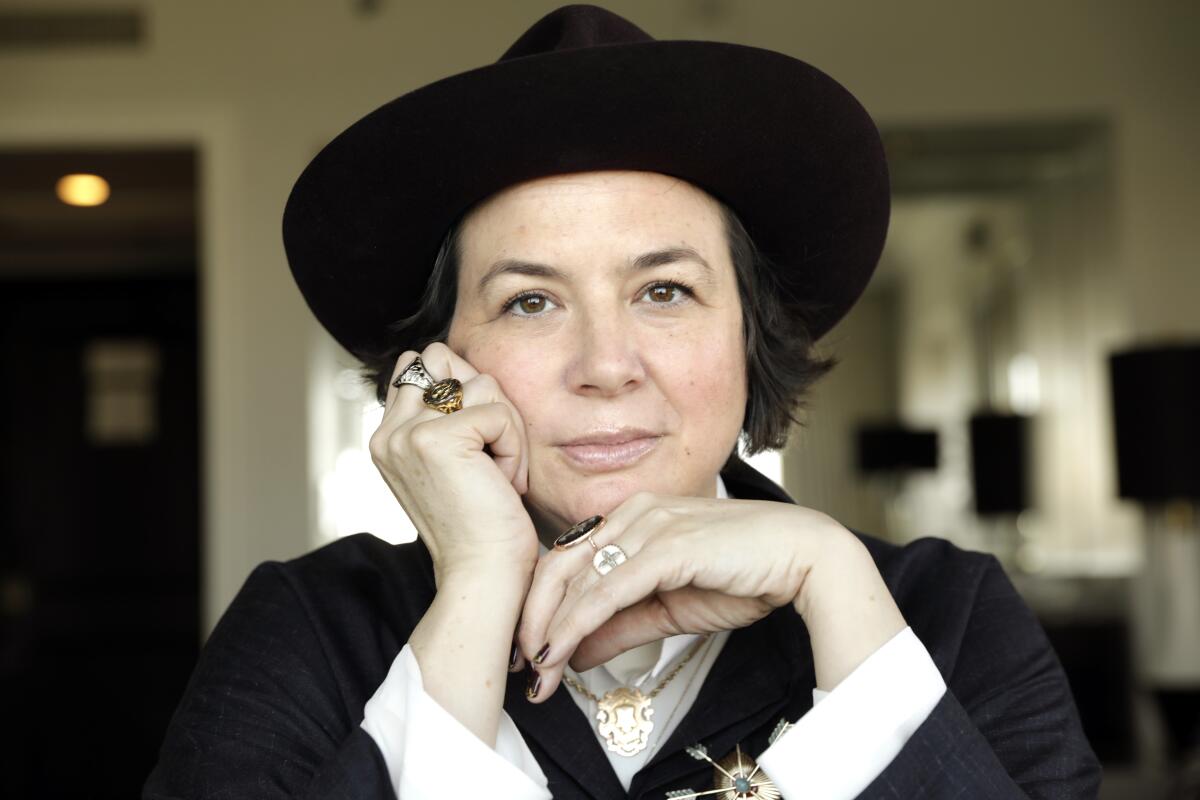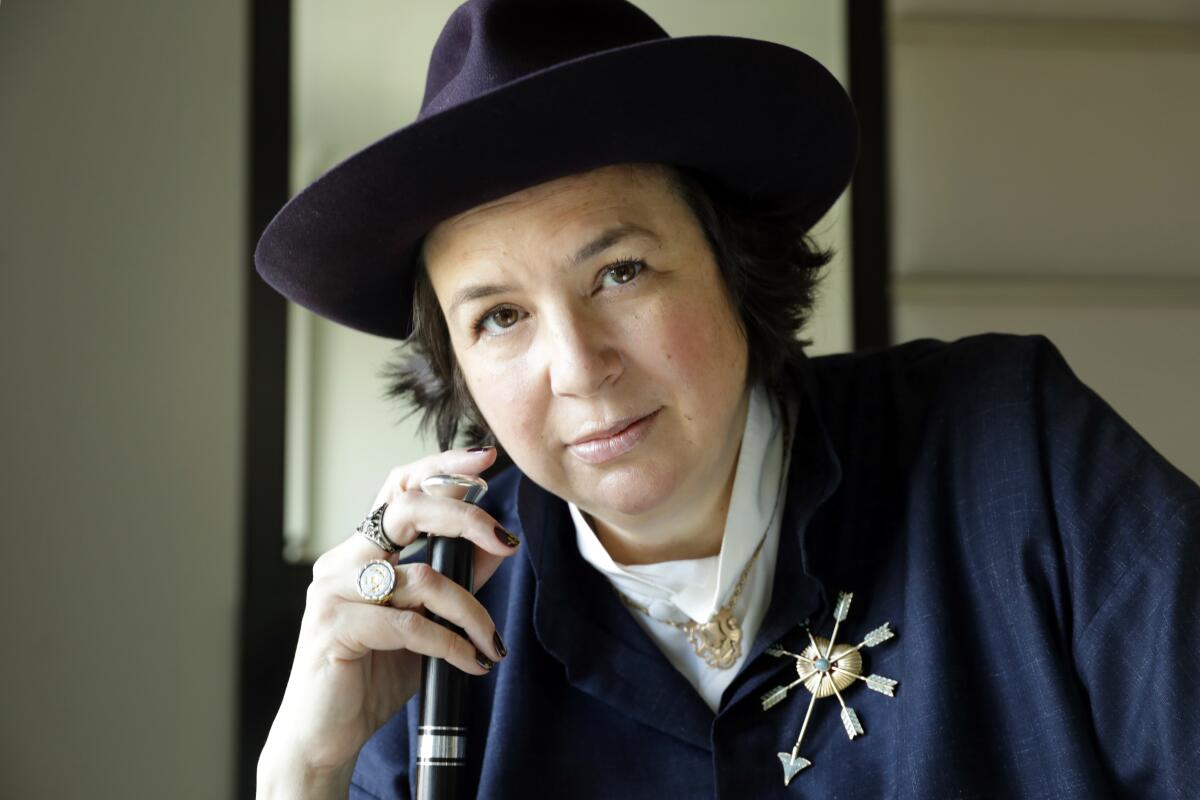Autumn de Wilde’s secret for directing your first film at 49? Keep whiskey in your cane

- Share via
When her arthritis got so bad that she needed a cane, Autumn de Wilde didn’t just pick one up at the pharmacy. She went to a 19th century Victorian umbrella shop in London and told the shopkeeper: “I need your weirdest cane.”
“Check this out,” she said, unscrewing the top of the French walking stick, supposedly modeled after one once owned by Henri de Toulouse-Lautrec. Inside was a thin vial containing Japanese whiskey, bookended by a couple of shot glasses. “These need a little wash, because we’ve partaken recently. It actually only holds a shot, which is so disappointing. I thought it was so much more when I bought it.”
The idea of following standard protocol is anathema to De Wilde. Every day, she dresses in a uniform — some version of a suit with a broad-brimmed felt hat. (She says her style is a mix of Paddington Bear and Oscar Wilde.) Her friends refer to her as “the rock ’n’ roll Martha Stewart” because at parties, she gifts everyone with handmade favors. Once, after spending two sleepless nights creating 150 paper robot invitations, her mother asked her: “Why don’t you just keep it simple?” De Wilde raged: “Don’t you know me by now? I will never! Keep it! Simple!”
But it was this sort of extravagance that helped her first big directing job, the new adaptation of Jane Austen’s “Emma,” which hit select theaters Friday. When she was asked to pitch the film’s financiers on her vision for the story (which has been filmed multiple times, including a 1996 version starring Gwyneth Paltrow and the 1995 modern update “Clueless”), she decided against a digital presentation.
Instead, in advance of their Skype meeting, she sent the executives a parcel wrapped in silk ribbon. Once everyone had virtually gathered, De Wilde instructed the team to open the box. Wrapped in newsprint, they found a set of cards she had curated to illustrate her fantasy film, complete with fashion illustrations from the 1800s, caricatures poking fun at society and lighting and design references.

Though she had never made a feature film, De Wilde had long become adept at the art of the pitch.
“On photo shoots, if I don’t talk to the musician about something that makes sense to them, they’ll panic and I’ll lose the job,” said De Wilde, who chose to meet at the Chateau Marmont a few hours before the Los Angeles premiere of “Emma” last week. “And when you’re a girl, you have to prove yourself for anything you haven’t done. I got good at putting people at ease so they wouldn’t have to suffer on my period.”
De Wilde, who will turn 50 this year, is best known for her work as a celebrity photographer. Over the last two decades, she has shot everyone from Willie Nelson to Robert Pattinson, Lena Dunham to Busy Phillips. She has documented the work of Rodarte designers Kate and Laura Mulleavy from the inception of their careers, and is often behind the camera for their fashion campaigns. In Los Angeles — she lives in a Glassell Park home — her friends include a hip collaborative of artists she has also photographed: the Mulleavy sisters, actress Zooey Deschanel, filmmaker Miranda July and singer Jenny Lewis.
July, who has watched De Wilde struggle for years to try to land her first film, said she was filled with emotion after attending the “Emma” premiere alongside the group.
“If there were more female directors, Autumn’s story wouldn’t be such a rare and precious thing to us,” she said. “Basically a single mom who worked so hard and at this age is coming into her own. I think we all feel really tender because it’s a very powerful example.”
De Wilde grew up in L.A., the daughter of two hippies who once lived on a commune called the Farm in the hills above Warner Bros. studios. Her father, Jerry de Wilde, was also a photographer who captured the late ’60s counterculture, shooting the likes of Jimi Hendrix and Frank Zappa. Her unconventional upbringing — at times, the family lived in her dad’s photo studio, where she bathed in the work sink — encouraged the younger De Wilde to figure out different ways of expressing herself.
In junior high, she recalled, she was bullied because of how tall and lean she was. (She is 6 feet 2, and her brother is 7 feet 2.) Tired of crying every day after school, she decided to embrace her Olive Oyl look. So she culled together the most bizarre outfit she could find: a Laura Ashley skirt covered with a tiered business slip, her father’s oversized suit coat and a pair of fluorescent socks.
“I think the boy I had a crush on was definitely freaked out, and I felt empowered by that,” she remembered. “I had this thing, like, ‘Oh, if I freak someone out, then they feel uncomfortable and I feel stronger.’ In him not getting why I was dressing like that, I felt excited — like for once he maybe wasn’t thinking how much I would die for him.”
After studying theater at Los Angeles City College, De Wilde found herself at Lollapalooza in 1995, performing political theater. At one point during the festival, she got stranded at a truck stop in Missouri and came down with heat stroke. The singer Beck let her cool down on his tour bus, and the two struck up a friendship. She took a few photographs of him, and he suggested she start taking the craft more seriously.
“He was like, ‘These are good. No one makes me look like I’m not a dumb kid,’” she said. The late musician Elliott Smith was also an early champion of her work, telling his record company that he would only do a music video if De Wilde could direct it.
Because of the early support from these men, De Wilde is reluctant to place blame on the men who have kept her from working in Hollywood. Her daughter, however, the 20-year-old Starcrawler singer Arrow, is less cautious. Earlier this month, she posted a picture of herself with her mom on Instagram, noting how happy she was to see her mother “prove all the men in hollywood who said she couldn’t do it WRONG.”
“It’s fun having my daughter throw blame all over the place,” De Wilde said of Arrow, whom she had with ex-husband Aaron Sperske, a drummer. “The truth is, I did lose a lot of jobs over the years. I would be the runner-up on a film where it seemed like it was a more comforting choice to choose the man. By the time I had a reel with music videos and commercials, it was obvious I wasn’t a risk...
“But I hesitate a bit to stand on a soap box and play the martyr, even though I’m totally justified. With every challenge, I was like, ‘OK, [jerks], I’m gonna learn more and come back better at what I do.’ If I went down the road of feeling sorry for myself, I wouldn’t be improving. There’s no age or achievement where you shouldn’t try to get better at what you do.”
On “Emma,” De Wilde said she felt more comfortable than she ever had on a set. She relished throwing all of her obsessive tendencies into one job, bringing out the pastel colors of the Georgian era or exploring how the restrictive fashion impacted character’s natures.
Anya Taylor-Joy, who was cast as the clever-but-meddlesome Emma Woodhouse, said De Wilde was fastidious about the look of the film — particularly the actress’ hairstyle.
“If a tendril was out of place, the whole scene stopped and we started again,” Taylor-Joy said with a laugh. “We had curlgate so many times — and bonnet gate. I knew how Autumn would want it before she’d even say it to me. I would be coming out of the carriage and I’d be, like, ‘You want me to do the pretty, don’t you?’ So I’d come out of the carriage, look over my shoulder and through some glass to make it look pretty.”
De Wilde said she found working with actors akin to her work on photo shoots, where she said she thinks she’s developed a reputation for “making a subject feel safe.” In the past, she said, she’s been turned down for Spin or Rolling Stone cover jobs because she was told she was “only going to do what the band wants.”
“As if that’s a bad thing — as if it’s a sign of weakness when the musician doesn’t feel raped by the concept,” she said with a scoff. “In making this movie, it was really useful that I’d spent years making it look like everyone I photographed slept with me. I was able to make it sensual, sexy, private — almost like a moment with a lover but I didn’t have to touch them or make them feel humiliated. Without interfering with the subject’s privacy, I’d say: ‘Look at the camera like an object.’ I realized you could fake intimacy with some basic body positions. And then they’d be like, ‘Oh my God, it looks like you were totally scamming on me.’”
July said she was keenly aware of this perspective while watching “Emma.” In the scene where the heroine’s best-friend-turned-eventual-lover Mr. Knightley is introduced, the audience first sees him in a state of undress: His bottom is bare, and a servant pulls stockings up over his calves.
“When I saw that, I was like, ‘Of course. That’s so Autumn,’” said July. “One of the things I was most struck by that seemed very intimately her is her female gaze on men and romance. When you look back through at the men she has photographed, she’s not afraid to take in what’s beautiful about a man’s body — this is how he’s childlike but also tough.... I just think it’s interesting in this moment, when you wonder what have we been missing — it’s a different way to see men. Of course we’ve missed women’s voices and stories, but men have missed out on a certain kind of tenderness that someone like Autumn can give. It’s interesting to think there may be some healing in that.”
De Wilde, however, views “Emma” as an offering of levity during a period of political unrest that makes us feel “like we’re all being bullied.” And she takes issue with those who view films with ornate scenery — like those of Wes Anderson, one of her creative inspirations — as pure fluff.
“I mean, have people seen ‘Moonlight’? There’s so much color in that movie, and it’s genius. It’s a strange idea that movies about pain and struggle should have color removed from them,” she said. “I don’t know why it’s been assigned to extravagance. I don’t walk into a pastry shop in Paris and go, ‘Why are all these colors here?’ I go, ‘That’s delicious, and I want to eat it.’ How it looks is part of the story.”
More to Read
Only good movies
Get the Indie Focus newsletter, Mark Olsen's weekly guide to the world of cinema.
You may occasionally receive promotional content from the Los Angeles Times.











